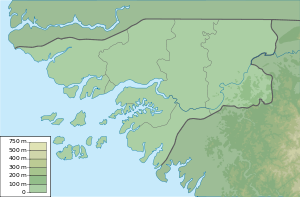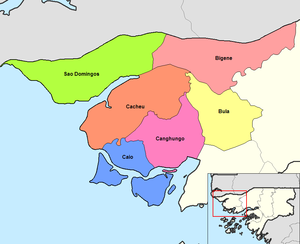Ilha de Pecixe
| Ilha de Pecixe | ||
|---|---|---|
| Map of the Bissagos Archipelago and neighboring areas to the north, with Pecixe in the northwest | ||
| Waters | Atlantic Ocean | |
| Geographical location | 11 ° 50 ′ N , 16 ° 5 ′ W | |
|
|
||
| length | 20.6 km | |
| width | 12.8r | |
| surface | 168 km² | |
| main place | Incante | |
| Pexice belongs to the Caió sector in the Cacheu region | ||
The Ilha de Pecixe is an island located off the coast of the West African country Guinea-Bissau in the Atlantic Ocean . It is located about 50 km west of the state capital Bissau in front of the mouth of the Rio Mansôa river . Their distance to the African mainland is about 3 km at the narrowest point. In the south, the wide Canal do Gêba separates the Ilha de Pecixe from the islands of the Bissagos Archipelago , 1500 meters west of it is the somewhat smaller neighboring island of Ilha de Jeta .
The island covers a land area of 168 km² and has a coastline of about 68 km.
Like Jeta, it belongs to the Caió sector in the Cacheu region .
The natural vegetation on Pecixe consists, as everywhere along the strongly indented coast of Guinea-Bissau, mainly of mangroves and swampy rainforest. The interior of the island is divided by numerous rivers. The climate is tropical with heavy rainfall in the summer months. In the past few decades, parts of the forests have been cleared for agricultural use.
The inhabitants of Pecixes belong to the Manjago (or Manjaku ) people. and speak, in addition to the national colloquial language Crioulo and the official language Portuguese , their own language, which belongs to the Atlantic branch of the Niger-Congo family.
Web links
- Entry in the UNEP Islands Directory
References and comments
- ↑ Manjacos in the Portuguese-speaking Wikipedia
- ^ Language map for Guinea-Bissau (Ethnologue), cf. Paragraph 25 ethnologue.com


